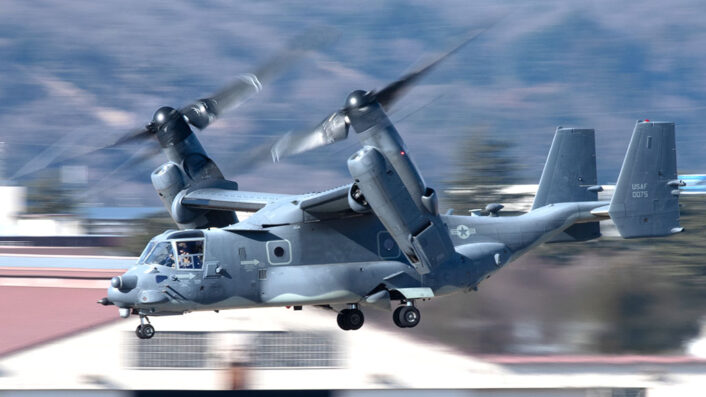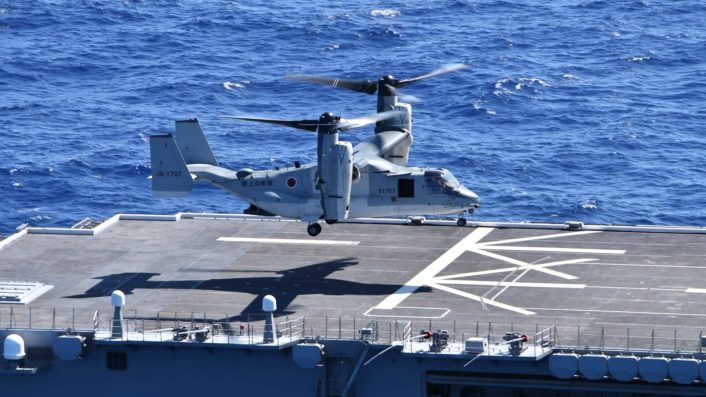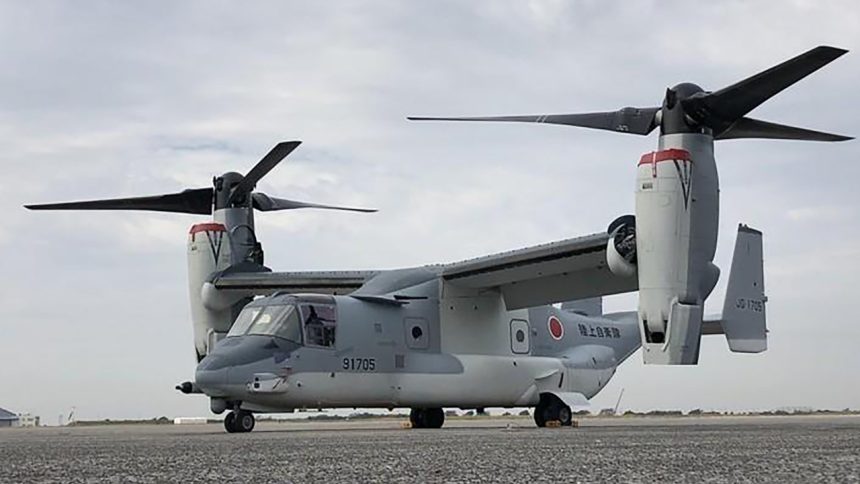Japan’s V-22 fleet resumed flights in March while Air Force has no specific timeline for when operations will resume.
On Nov. 29, 2023, a U.S. Air Force Special Operations Command CV-22B crash, which killed eight service members, led to a safety standdown of about 400 Osprey aircraft. The incident, the fourth in two years, grounded the worldwide fleet of tilt-rotor aircraft. The US military operates three different Osprey versions: the Marine Corps, fly the MV-22B; the U.S. Navy flies the CMV-22 carrier onboard delivery logistics aircraft and the U.S. Air Force operates the CV-22B. The JGSDF (Japan Ground Self-Defense Force) operates a total of 14 Ospreys with three more to be delivered to complete an order of 17 aircraft.
The V-22 Osprey has faced a series of groundings due to past accidents. The latest prolonged grounding prompted the military services to implement measures to prevent a capability gap until the Osprey could be cleared for flight again.
To ensure continuity in operations, the U.S. Navy increased the deployment of its remaining C-2A Greyhounds to fulfill Carrier Onboard Delivery missions. Similarly, the U.S. Army utilized CH-47F Chinook helicopters to substitute for the MV-22s from the USMC’s Marine Helicopter Squadron One (HMX-1) and to support presidential airlift missions.
Despite the grounding, a few USMC MV-22s deployed to Djibouti were exempted from the restriction as of January 17, 2024, due to operational needs and have since flown without any reported incidents.
Phased’ Resumption of Osprey Operations
In March, during the ongoing investigation of the incident, the Air Force disclosed that they had identified the cause of the crash but were still investigating the specific reason for the failure. As a precautionary measure, additional safety checks and more conservative operations with the Osprey were planned to address the known material failure. These measures were also intended to be communicated to Japan, the sole foreign operator of the V-22.

It was anticipated that flight operations of the tiltrotor in Japan would be temporarily suspended until further notice. Specifically, the head of NAVAIR was scheduled to travel to Japan to brief the Ministry of Defense and the Japanese government on the situation, and no Ospreys would resume flight operations until after this briefing had taken place.
On March 13, 2024, the Japanese Ministry of Defense announced that the Japanese Ground Self-Defense Forces (JGSDF) and the US Military had reached an agreement to gradually resume regular operations of the MV-22s in the country in a phased approach. The initial focus would be on restoring pilot proficiency to a high safety standard, particularly in proximity to airports.
Here the translated version of the statement:
Following the lifting of the Osprey operation suspension on March 8, each branch of the U.S. military will resume operations in a timely manner in accordance with its own guidelines, but within Japan, the two branches have been closely coordinating on the timeline for resuming operations. The process leading up to the resumption of operations will differ from unit to unit depending on each unit’s mission, operational requirements, and the status of implementation of various safety measures, but Japan and the U.S. have been coordinating on the future process while taking these differences into account.
Going forward, the JGSDF’s Ospreys and the U.S. military’s Ospreys in Japan will be gradually restored to their mission capabilities. Specifically, first of all, maintenance and training will be carried out as outlined in the safety measures to prevent a recurrence of the recent accident.
Once these maintenance and repairs have been completed, the aircraft will begin basic flights one by one to regain their proficiency. These basic flights will be conducted at the discretion of each unit’s commander after necessary safety measures have been taken and preparations are complete. However, it has been confirmed that the Ospreys of the Japan Ground Self-Defense Force and the U.S. military in Japan will begin flying one by one after March 14, starting with those that are ready.
The recovery period for basic skill proficiency varies from unit to unit, and is a process that will take a certain amount of time. After the first flight, the JGSDF’s Ospreys will fly in the airspace around the airfield for the time being, and once they have regained the necessary level of proficiency, they will move on to the next stage of training. The U.S. side has also confirmed that they will carefully proceed with the process of resuming operations in stages. In addition, this process will not mean that all Ospreys will begin flying at once, but will be carried out in stages, starting with aircraft that have completed preparations such as maintenance.
Through this careful process, units that have regained basic skill proficiency will then gradually undergo basic missions and more advanced training before regaining the ability to handle the required missions.
The Ministry of Defense and the U.S. Forces Japan Command have reaffirmed that ensuring flight safety is the top priority when resuming Osprey operations, and have confirmed that they will proceed with this process carefully while taking every possible measure to ensure safety, and that the aircraft will be gradually returned to missions after taking the necessary measures for the defense of Japan, including the southwestern region.
On March 14, the US Marines conducted their inaugural flight of Japanese-based V-22 operations. About one week later, the JGSDF conducted its first V-22 flight from Camp Kisarazu in Chiba Prefecture, located near Tokyo.
Another V-22 Osprey arrived at the Kisarazu Garrison on June 5, 2024, Japan’s NHK News reported. The deployment of the JGSDF’s Osprey at the Kisarazu Garrison is “provisional,” the Japanese report added. The said Osprey is also the fifteenth aircraft that arrived from the US military’s Iwakuni Base in Yamaguchi Prefecture. Two more aircraft are scheduled for temporary deployment at Kisarazu, and are “expected to arrive as soon as inspections and maintenance at Iwakuni Base are completed.”

Meanwhile, the 21st Special Operations Squadron (SOS), stationed at Yokota Air Base, Japan, which tragically lost six airmen in the crash, has yet to resume CV-22 flights. According to Lt. Col. Matt Davis, the commander of the 21st SOS, there is currently no specific timeline for when operations will resume, as reported by Breaking Defense.
In fact, while JGDSF and US Marine Corps V-22s resumed flight operations in Japan, AFSOC have not revealed the exact steps units will take to return the Osprey to full flight capability; nevertheless, according to the report by Breaking Defense’s Valerie Insinna, the two squadrons stationed at Yokota, have already started working in anticipation of their first flight since the standdown: the 21st SOS is conducting ground-based V-22 simulator training twice daily, five days a week, with aircrews undergoing a thorough program focused on emergency procedures, while maintainers are utilizing the period typically allocated for aircraft repairs to incorporate training objectives into phased inspections of the CV-22s. These inspections, known as phased inspections, involve a comprehensive evaluation of the tiltrotor after a predetermined interval of time.









